First Mass Demonstration Against The 'Tag'
Originally posted to El Cantar de la Lluvia on Saturday, May 12, 2007
A few years ago, construction and operation rights for new urban highways in Santiago were handed over to a few corporations. The promise to all was that traffic congestion would be reduced, travel times would be slashed down to mere minutes versus large parts of an hour, and that safety on the road would increase.
Fast forward to the present, and Santiago now sports four new autopistas urbanas, urban highways:
A telepay scheme was crafted, and radiofrequency billing tags were handed out for free to car owners. Portals were set up along the highway, and users were charged according to the number of portals they crossed, the pricing of each segment, and the time of day.
The highways are indeed a pleasure to drive and ride on. They have a proper team of emergency services, emergency phones every certain distance, clear markings and (for the most part) a good design.
When the concession was granted by the government, no one thought to mention motorcycles. This is one of those typical oversights that rear their head a few years down the road when someone realises that this oversight is actually potential income.
The highway operators started making noises about charging motorcycles for using the highways. In the following weeks, a lot of FUD was spouted to eager and unquestioning news reporters about the "illegality" of bikes not paying for using the highways.
Us, we just watched it from a distance. A few forum posts here and there trying to spurr us to action were met with apathy and a "meh, it'll blow over, like everything else" attitude.
Well, it didn't. The operators began testing smaller electronic tags for motorcycle use, all the while repeating the line that "motorcycles must pay the same amount as cars".
This was the key point: while most of us found the idea of paying for the highways appropriate, it was the amount we were being required to pay that we disagreed with.
First, because not a single driver in Santiago is happy with the pricing scheme used on the autopistas urbanas. They are extremely expensive, are often the only way to get from point A to point B, a considerable number of citizens cannot avoid them when leaving or returning to their home, and there is no way of entering or leaving Santiago without paying. This applies to vehicles coming from other cities, who must buy a "day pass" or face stiff fines for not carrying an electronic tag.
On top of that, we were being asked to pay the same as a car, something unheard of in Chile. The only logic under which it was understandable was that in which milking administrative oversights for your own profits is a priority. And to add insult to injury, we were being asked to pay for the device.
So what did we do? We got mad. And took to the streets.

A grey, grey day, and air quality indicators nearly off the scale. This is where we met (clicky clicky).

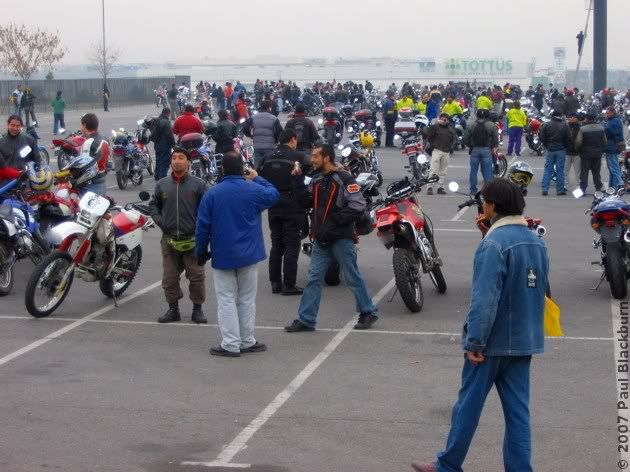
There was good organization: all bikes were segregated according to style.

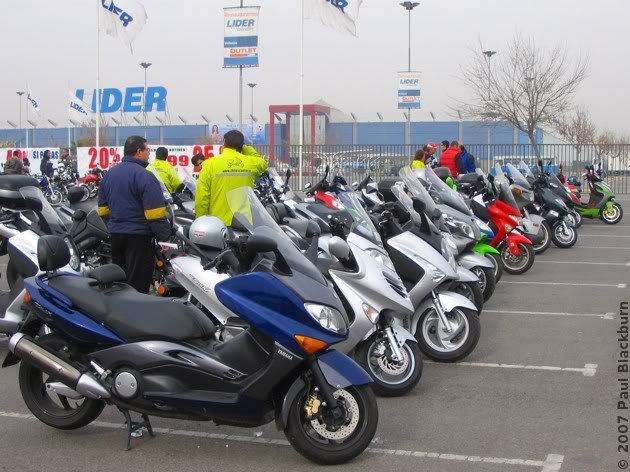

Jano and Kary went to get some food in the Lider, so Camilo and I re-decorated his bike.
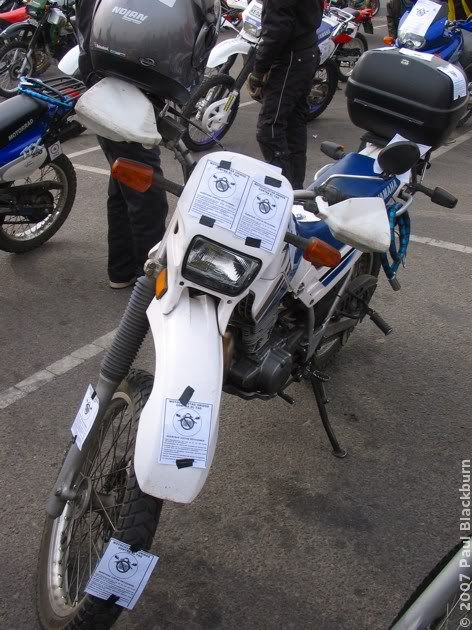
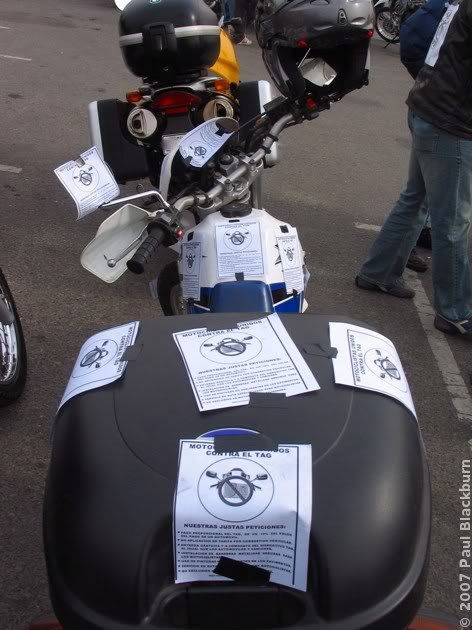
Everyone had covered their license plates, most using black electrical tape or the very flyers that were being handed out. This, however, is probably the most original method I saw that day.


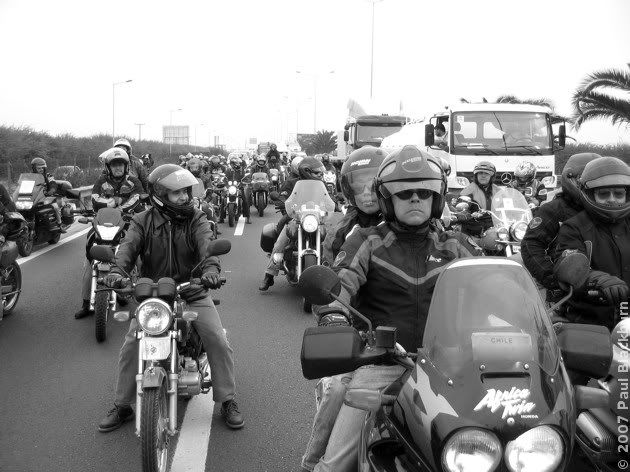
This is where we stopped. It was havoc back there. The Panamerican Highway was choked off for nearly half an hour. People looked down from street level, and said hi.

Camilo.

A Goldwing and Casi's 100 cc Hero Honda Passion.


Let us hope this achieves something.
Part two continues here.
A few years ago, construction and operation rights for new urban highways in Santiago were handed over to a few corporations. The promise to all was that traffic congestion would be reduced, travel times would be slashed down to mere minutes versus large parts of an hour, and that safety on the road would increase.
Fast forward to the present, and Santiago now sports four new autopistas urbanas, urban highways:
- Autopista Central - Running North/South through the middle of the city, it's the old Ruta 5, also known as the Pan-American highway.
- Costanera Norte - A ballsy project that actually worked: An underground urban highway, crossing Santiago's north end from East to West, with a large section of it running under the Mapocho river.
- Américo Vespucio Norte (Vespucio Norte Express) - The northern section of Santiago's ringroad.
- Américo Vespucio Sur (Autopista Vespucio Sur) - The south section.
A telepay scheme was crafted, and radiofrequency billing tags were handed out for free to car owners. Portals were set up along the highway, and users were charged according to the number of portals they crossed, the pricing of each segment, and the time of day.
The highways are indeed a pleasure to drive and ride on. They have a proper team of emergency services, emergency phones every certain distance, clear markings and (for the most part) a good design.
When the concession was granted by the government, no one thought to mention motorcycles. This is one of those typical oversights that rear their head a few years down the road when someone realises that this oversight is actually potential income.
The highway operators started making noises about charging motorcycles for using the highways. In the following weeks, a lot of FUD was spouted to eager and unquestioning news reporters about the "illegality" of bikes not paying for using the highways.
Us, we just watched it from a distance. A few forum posts here and there trying to spurr us to action were met with apathy and a "meh, it'll blow over, like everything else" attitude.
Well, it didn't. The operators began testing smaller electronic tags for motorcycle use, all the while repeating the line that "motorcycles must pay the same amount as cars".
This was the key point: while most of us found the idea of paying for the highways appropriate, it was the amount we were being required to pay that we disagreed with.
First, because not a single driver in Santiago is happy with the pricing scheme used on the autopistas urbanas. They are extremely expensive, are often the only way to get from point A to point B, a considerable number of citizens cannot avoid them when leaving or returning to their home, and there is no way of entering or leaving Santiago without paying. This applies to vehicles coming from other cities, who must buy a "day pass" or face stiff fines for not carrying an electronic tag.
On top of that, we were being asked to pay the same as a car, something unheard of in Chile. The only logic under which it was understandable was that in which milking administrative oversights for your own profits is a priority. And to add insult to injury, we were being asked to pay for the device.
So what did we do? We got mad. And took to the streets.

Saturday 12th May, 2007
23:54
By Paul Blackburn
SANTIAGO.- More than 4000 motorcyclists gathered today in a long caravan to protest against the so-called "tag", an electronic billing device, that has become an icon of the discontent caused by the urban highway operators' intentions of implementing unfair and abusive charges for motorcycles.
Their demands included a tiered pricing scheme for motorcycles, free delivery of the tag, highway emergency services that take motorcycles into account, the use of non-slip road markings and the re-design of impact barriers, currently posing a lethal risk to motorcyclists involved in an accident. This last point echoes that of mass demonstrations in other countries, such as Spain.
The caravan's meeting point was the parking lot of the Lider supercenter, at the intersection of the General Velásquez and Américo Vespucio urban highways.
Under police supervision, motorcyclists began their journey going north on Américo Vespucio Norte. The caravan stopped several times, completely blocking the passage of other vehicles. Carabineros motorcyclists forcefully freed the left lane in some segments to allow cars and trucks to pass.
Upon reaching the La Pirámide sector, they stopped again, under the curious gaze of the workers constructing the tunnel that will soon cross Cerro San Cristóbal from side to side. The motorcyclists continued up Autopista Costanera Norte, creating kilometres of backed up traffic in the underground sections. They then emerged to the surface, passed the Centro Cultural Estación Mapocho, and entered the Autopista Central, headed south.
It was here, near the Toesca exit, that all traffic was completely paralyzed for approximately 25 minutes.
Once the stop was over, they continued South once more, eventually reaching their starting point.
A grey, grey day, and air quality indicators nearly off the scale. This is where we met (clicky clicky).


There was good organization: all bikes were segregated according to style.



Jano and Kary went to get some food in the Lider, so Camilo and I re-decorated his bike.


Everyone had covered their license plates, most using black electrical tape or the very flyers that were being handed out. This, however, is probably the most original method I saw that day.



This is where we stopped. It was havoc back there. The Panamerican Highway was choked off for nearly half an hour. People looked down from street level, and said hi.

Camilo.

A Goldwing and Casi's 100 cc Hero Honda Passion.


Let us hope this achieves something.
Part two continues here.

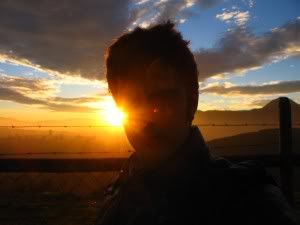
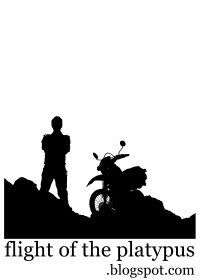

 The Lagoons of the Santuario de la Naturaleza 2: Laguna Los Ángeles
The Lagoons of the Santuario de la Naturaleza 2: Laguna Los Ángeles Race Day At Leyda 4
Race Day At Leyda 4 El Tabo and the Central Hidroeléctrica El Sauce
El Tabo and the Central Hidroeléctrica El Sauce Exploring The Hills Around Lampa
Exploring The Hills Around Lampa A Different Route To Baños De Colina
A Different Route To Baños De Colina The Mines of the Cuesta La Dormida
The Mines of the Cuesta La Dormida The Frozen Lagoons of the Santuario de la Naturaleza
The Frozen Lagoons of the Santuario de la Naturaleza Second Mass Demonstration "For A Fair Tag"
Second Mass Demonstration "For A Fair Tag" First Mass Demonstration Against The 'Tag'
First Mass Demonstration Against The 'Tag' Enduro In Lagunillas
Enduro In Lagunillas Embalse El Yeso and Termas Del Plomo
Embalse El Yeso and Termas Del Plomo Ride To Peñuelas
Ride To Peñuelas Cerro Chena
Cerro Chena Race Day at Leyda 3
Race Day at Leyda 3 Baños de Colina 2
Baños de Colina 2 Carretera Austral: Epilogue
Carretera Austral: Epilogue The Little Giant and Termas del Plomo
The Little Giant and Termas del Plomo Back on Two Wheels
Back on Two Wheels 2006 Photographic Retrospective
2006 Photographic Retrospective Race Day At Leyda 2
Race Day At Leyda 2  Quantum Optics III in Pucón
Quantum Optics III in Pucón Meseta In Chicureo
Meseta In Chicureo Pick Up Your Beer Bottle And Fuck Off
Pick Up Your Beer Bottle And Fuck Off  Planes And Hills
Planes And Hills Cut-Off Road
Cut-Off Road Lagunillas
Lagunillas Laguna Verde 2
Laguna Verde 2 Ride To Anywhere But Aculeo
Ride To Anywhere But Aculeo Cerro El Roble, Second Attempt
Cerro El Roble, Second Attempt Baños De Colina
Baños De Colina Some Walk On Water...
Some Walk On Water... Race Day At Leyda
Race Day At Leyda Almost Cerro El Roble
Almost Cerro El Roble Off To Curacaví with Andrés
Off To Curacaví with Andrés La Serena, Part 3: Back To Santiago
La Serena, Part 3: Back To Santiago  A Bull, Two Cows and a Chilean Fox
A Bull, Two Cows and a Chilean Fox Escape To Cuesta La Dormida
Escape To Cuesta La Dormida Valve Adjustment
Valve Adjustment La Serena, Part 2B: Valle Del Elqui
La Serena, Part 2B: Valle Del Elqui La Serena, Part 2A: Coquimbo and La Recova
La Serena, Part 2A: Coquimbo and La Recova Mud And Pine Trees
Mud And Pine Trees La Serena, Part 1
La Serena, Part 1 Pimp My Exhaust
Pimp My Exhaust Ride To Laguna Verde
Ride To Laguna Verde Ride To La Mina
Ride To La Mina Ride To Termas El Plomo
Ride To Termas El Plomo Camping in Colliguay
Camping in Colliguay Ride To Portillo
Ride To Portillo Ride To Olmué and Con Con
Ride To Olmué and Con Con Siete Tazas
Siete Tazas Watching The Departure Of The Day That Brought Me Here
Watching The Departure Of The Day That Brought Me Here Buenos Aires Motorbikes
Buenos Aires Motorbikes Ride to Talca with the Adach Group
Ride to Talca with the Adach Group Las Trancas '05
Las Trancas '05 Towers and Hills
Towers and Hills María Pinto, Melipilla, Aculeo
María Pinto, Melipilla, Aculeo Me and my Carb
Me and my Carb




0 Comments:
Post a Comment
<< Home